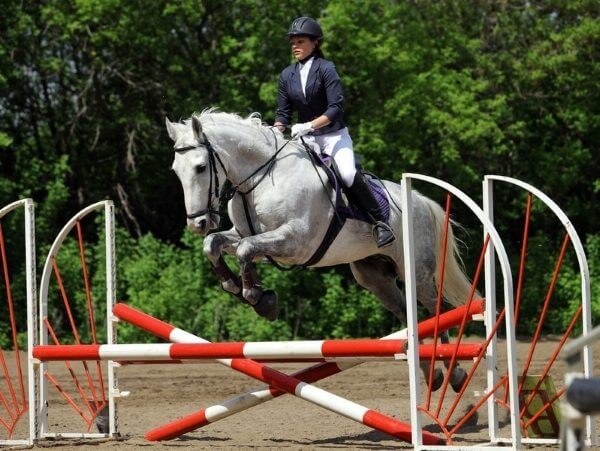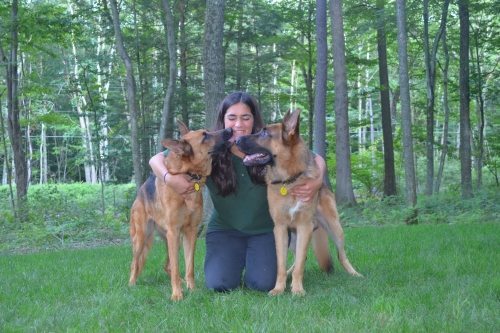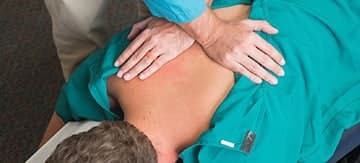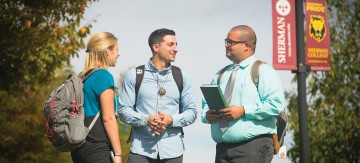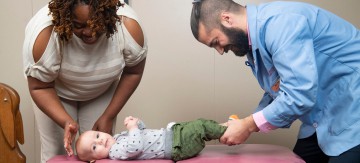[et_pb_section bb_built=”1″ admin_label=”section”][et_pb_row admin_label=”row”][et_pb_column type=”4_4″][et_pb_text _builder_version=”3.0.93″ background_layout=”light” border_style=”solid” header_text_align=”center”]
Unique Career Paths: Animal Chiropractor
[/et_pb_text][et_pb_text]
Chiropractic has long been recognized for its capacity to help human bodies perform at their best. But over the last few decades, animal adjustment has also expanded in practice and appeal, offering new career paths to students currently enrolled in chiropractic training. Read on to learn more about the evolution of animal chiropractic, and how one Sherman graduate transformed her passion for horses into a thriving private practice.
History of Chiropractic Practice on Animals
Animal chiropractic originated around 1895, at about the same time human chiropractic was developed. The practice, however, did not gain wider appeal until 1985 when the late Sharon Willoughby, a veterinarian, and chiropractor, took the reins of an organization called Options for Animals, which provided instruction on how to adjust animals.
In 1986, Dr. Willoughby gave a short course on equine chiropractic (spinal adjustment for horses) in Arkansas. Following the workshop, participants – a mix of veterinarians and chiropractors – formed the American Veterinary Chiropractic Association (AVCA) and chose Dr. Willoughby as their president.
The AVCA was among the very first to develop an educational curriculum around chiropractic theory and technique, build a link between chiropractic and veterinary practitioners and ultimately, apply chiropractic care to the quadruped.
Throughout the last decade, the public acceptance and demand for animal chiropractic care have grown, inspiring new graduates of chiropractic college to pursue this rewarding career path. One of those graduates is Natasha Jaskiewicz, D.C.
Natasha’s Success Story
Born in Singapore, Natasha Jaskiewicz moved with her family to Anacortes, WA in 1985 at the age of three. Natasha has always been an avid animal lover, and from a young age, she owned her own horses. She became involved with 4-H early on and began to train and show horses, especially hunter/jumpers.
Natasha graduated from the University of Findlay in Ohio with a degree in equine business management and soon began working as a freelance horse trainer, first in Washington and later in Texas. In Texas, Natasha encountered a Certified Animal Chiropractor who was also a D.C. and was truly amazed at the work she did with horses. After witnessing how applied animal chiropractic helped horses naturally, without drugs or surgery, Natasha was inspired to pursue a brand new career path.
Upon graduating from Sherman College of Chiropractic in 2007 and obtaining national certification by the American Veterinary Chiropractic Association, Natasha established a mobile practice that specializes in animals. Now she travels throughout the Carolinas and across the globe, working not only with horse and rider teams but also with a variety of other animals including conformation and agility dogs that compete at international levels. Natasha is truly an inspiring example for anyone looking to combine a chiropractic education with a love of animals.
The Benefits of Animal Adjustment
Approaching chiropractic care for animals is (for obvious logistical reasons) quite different than with humans – but the rationale for doing so, and the benefits of chiropractic, are surprisingly similar for both. Vigorous activity, repetitive actions, or wear and tear due to aging are experienced by animals just as they are by humans. Consider the physical force required of racehorses, the shock absorbed by a dog’s body after a high leap, the effects of a lifetime of wearing collars or saddles…the list goes on. Regular chiropractic adjustment helps mitigate those daily stressors, keeping the spine aligned and the central nervous system functioning optimally – best practice for any living creature, two-legged or four.
What would inspire you to pursue a career in animal chiropractic?
[/et_pb_text][/et_pb_column][/et_pb_row][et_pb_row _builder_version=”3.0.49″ background_position_1=”top_left” background_repeat_1=”no-repeat” background_position_2=”top_left” background_repeat_2=”no-repeat” background_position_3=”top_left” background_repeat_3=”no-repeat”][et_pb_column type=”1_3″][et_pb_post_nav _builder_version=”3.0.49″ in_same_term=”off” hide_prev=”off” hide_next=”on” border_style=”solid” border_color=”#0c71c3″ title_font=”|on|||” title_font_size=”16px” /][/et_pb_column][et_pb_column type=”1_3″][/et_pb_column][et_pb_column type=”1_3″][et_pb_post_nav _builder_version=”3.0.49″ in_same_term=”off” hide_prev=”on” hide_next=”off” border_style=”solid” border_color=”#0c71c3″ title_font=”|on|||” title_font_size=”16px” /][/et_pb_column][/et_pb_row][/et_pb_section]
